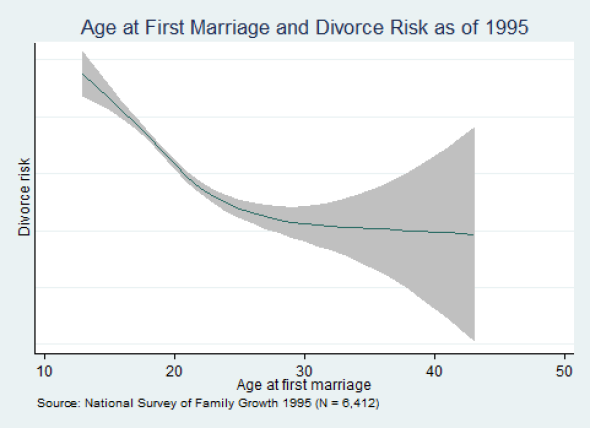The Goldilocks Theory of Marriage
婚姻中的“金发姑娘理论”
作者:Jordan Weissmann @ 2015-7-16
译者:ShawnLai
校对:带菜刀的诗人
来源:Slate杂志,http://www.slate.com/blogs/moneybox/2015/07/16/getting_married_late_increases_your_chance_of_a_divorce.html
Conventional wisdom, and many years of social science, have long said that the longer people wait to get married, the less likely they are to get divorced. There are obvious reasons why. With age, people mature, finish school, and settle into careers, which gives them the emotional and financial wherewithal to manage lifelong romantic commitments. The more we settle into ourselves, the theory goes, the better we are at settling down with others.
传统观点和多年来的社会科学界一直都认为,人们结婚越晚,越不容易离婚。道理很明显,随着年龄增长,人们的人格得以成熟,学业得以完成,事业得以稳定,这些条件为做出情感上、经济上的终生承诺提供了资本。根据这种理论,我们自己越安定,就越擅于成家立业。
A new analysis by Nicholas Wolfinger, a sociologist at the University of Utah, challenges that idea a bit. Using data from the National Survey of Family Growth, he finds that today, divorce risk declines for people who wait until their late 20s and early 30s to get married. But it rises again for those who delay walking down the aisle until their late 30s.
来自犹他大学(University of Utah)的社会学家Nicholas Wolfinger的一项新研究,对上述观点提出了挑战。根据国家家庭成长调查(National Survey of Family Growth)的数据,他发现,如今,对于等到三十来岁再结婚的人来说,离婚风险是下降的,但如果推迟到年近40岁才步入婚姻殿堂,离婚风险会再次升高。
Again, this seems to be a new phenomenon. Wolfinger finds that during the mid-1990s, the odds of getting divorced continued declining the longer individuals held off on their first marriage. (For our purposes, just pay attention to the blue trend line. The gray shaded areas represent what are known as confidence intervals.)
Wolfinger的另一发现发现似乎也是个新现象。1990年代中期,首次结婚年龄越大的人,他们的离婚概率就越低。(出于本文目的,只要关注蓝线就可以了,灰色阴影区域是置信区间)
 But now, the trend is u-shaped. “My data analysis shows that prior to age 32 or so, each additional year of age at marriage reduces the odds of divorce by 11 percent,” he writes. “However, after that the odds of divorce increase by 5 percent per year.” Call it the Goldilocks theory of marriage: Getting married too early is risky, but so is getting married too late. Your late 20s and early 30s are just right.
But now, the trend is u-shaped. “My data analysis shows that prior to age 32 or so, each additional year of age at marriage reduces the odds of divorce by 11 percent,” he writes. “However, after that the odds of divorce increase by 5 percent per year.” Call it the Goldilocks theory of marriage: Getting married too early is risky, but so is getting married too late. Your late 20s and early 30s are just right.
但是现在,这个趋势是U型的。 “我的数据分析显示,32岁左右之前,年龄每增加一岁,离婚的风险就会降低11%。”他写道,“然而在此之后,离婚风险就会每年增加5%。”我把它称为婚姻中的金发姑娘理论:结婚太早风险很高,但是结婚太晚也一样。三十来岁刚刚好。【编注:金发姑娘理论指地球位于不近不远刚好适合的轨道,“金发姑娘”典出儿童故事《三只小熊》:主人公金发姑娘发现小熊家的一样三份的东西中,总有一份偏于一端,一份偏于另一端,而一份刚刚好。】
 How come? Wolfinger isn’t sure. But controlling the data for demographic and personal characteristics such as race, education, religion, sexual history, family background, or the size of the cities survey takers lived in didn’t change the results, suggesting none of those factors could explain it.
How come? Wolfinger isn’t sure. But controlling the data for demographic and personal characteristics such as race, education, religion, sexual history, family background, or the size of the cities survey takers lived in didn’t change the results, suggesting none of those factors could explain it.
为什么会这样?Wolfinger也不确定。但是,在控制了诸如种族、教育、宗教、性经历、家庭背景、调查对象所在的城市规模等人口和个人特征之后,结果没有改变,说明以上因素不能解释这个现象。
Ultimately, the professor suspects that there’s a lot of self-selection at play: The sorts of people who wait a very long time to say “I do” just might not really be the marrying types, whether they realize it or not. Or, even if they are, their dating pool might have been whittled down to people who aren’t.
最终,Wolfinger教授怀疑这是自我选择的作用:那些拖了很长时间才结婚的人,无论自己是否意识到,晚婚的他们也许根本就不适合步入婚姻殿堂。或者,即使他们自己是适合结婚的人,他们约会对象的范围也收窄到那些不适合结婚的人了。
But that would explain today’s pattern, not the change we’ve seen since the turn of the century. And the reason behind that shift is also mysterious. “This is the $64,000 question,” he told me. “I honestly don’t have a great explanation. What I know for certain is it has happened.”
但是这个说法只解释了今天的情况,而没有解释这个世纪以来发生的变化。这些变化背后的原因依然是谜。“这是一个‘64,000美元难题( $64,000 question)’”【译注:这是1955年CBS推出的一档高额奖金电视问答节目】,Wolfinger教授说,“我真的没有好的解释,我唯一能确认的是,这样的事的确发生了。”
Jordan Weissmann is Slate’s senior business and economics correspondent.
Jordan Weissmann是Slate杂志的资深商业与经济学通讯记者。
(编辑:辉格@whigzhou)
*注:本译文未经原作者授权,本站对原文不持有也不主张任何权利,如果你恰好对原文拥有权益并希望我们移除相关内容,请私信联系,我们会立即作出响应。
——海德沙龙·翻译组,致力于将英文世界的好文章搬进中文世界——

 订阅
订阅
暂无评论
发表评论